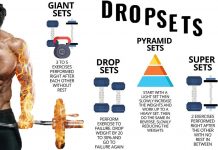✅ THE HACK SQUAT ✅

HOW TO:
- For this movement set your back up against the padding with your feet placed about shoulder width and slightly turned out.
- From there make sure you have a grip on the handles you’re gazing ahead, brace your core and begin to lower the weight.
- Make sure that your knees are NOT collapsing inwards inside your feet which causes and unnecessary amount of stress on your knee joint and can lead you to some knee irritations.
[wp_ad_camp_2]
- Instead, focus on keeping the knees tracking over your feet so you can have better stability force transfer during the execution of this movement.
- Think “KNEES NOT IN” if your struggle with this or simply place a band around your knees and that will force you to focus on driving your knees out so they don’t collapse inwards.
✅ FRONT SQUAT GRIP ✅
Both of these grips are proper ways to grip the bar when front squatting.

Below are some reason why one some lifter might prefer one over the other.
- Top Grip: The mobility/ flexibility gods such as Olympic lifters commonly use the “Front Rack” position. This typically requires good wrist mobility. Having long fingers help too lol. For this one grip slightly outside shoulder width with as many fingers on the bar as posible, you’re seeing 2 here because four usually requires more wrist mobility.
- Bottom Grip: “Arms Crossing” This one is more commonly used with bodybuilders, powerlifters and those whom lack wrist, shoulder and thoracic mobility in general.** This is usually more comfortable for heavier lifters or those with big biceps.
[wp_ad_camp_4]
🔥 Additional option: Use wrist wraps tightly around the bar.
Regardless of the grip ensure the bar is being primarily supported by the shoulders. Furthermore, Try to maintain the elbows as close to parallel to the floor as possible.
This usually allows you to maintain your t-spine locked in position so your chest doesn’t collapse forward.( t-spine mobility can certainly prohibit you from getting in the ideal position as well )
🚨 NOTE: If mobility is an issue focus on improving that first. Also, pick loads that allow you to keep your elbows up and work your way up from there.
🔥 IS YOUR SQUAT UN-STABLE⁉️
In order to have the most mechanically sound squat, you need stability both at the knees AND feet.

[wp_ad_camp_3]
What this means is that your knees should track over your toes regardless of stance if you want to produce an efficient amount of force in the most effective/ safest manner possible.
That being said, a cause of why your squat might be unstable and you’re potentially being cut off your power/ strength is due “knee valgus” which can be caused by flat feet/ foot pronation resulting in internal rotation of the knee/ hip such as in the picture above and this can cause knee issues over time.
Other factors that can attribute to “Knee Valgus” that are fixable [ not genetic structure ] can be weak abductors relative to adductors and if that’s the case you’ll have strengthened them.
I know some of you will say “well, so and so knees buckle and they’re a top level lifter”. My thing with “knee valgus” is, was it controlled or was it NOT controlled? In the sense of active structures stabilizing the knee it or just passive structures working which can lead to an injury.
My advice would be to strengthen those imbalances, work on your foot’s arch and lower the load if you need to so that you’re able to get strong with the most efficient motor patterns for the sake of longevity in the game.
✅SQUAT: [STABLE SQUAT]❌
In order to have the most mechanically sound squat, you need stability both at the knees AND feet.
[wp_ad_camp_5]
That being said, a cause of why your squat might be unstable and you’re potentially being cut off your power/ strength is due “knee valgus” which can be caused by flat feet/ foot pronation resulting in internal rotation of the knee/ hip such as in the picture above and this can cause knee issues over time.
Other factors that can attribute to “Knee Valgus” that are fixable [ not genetic structure ] can be weak abductors relative to adductors and if that’s the case you’ll have strengthened them.
[wp_ad_camp_1]
I know some of you will say “well, so and so knees buckle and they’re a top level lifter”. My thing with “knee valgus” is, was it controlled or was it NOT controlled? In the sense of active structures stabilizing the knee it or just passive structures working which can lead to an injury.
My advice would be to strengthen those imbalances, work on your foot’s arch and lower the load if you need to so that you’re able to get strong with the most efficient motor patterns for the sake of longevity in the game.





































![SQUAT: [STABLE SQUAT]](https://weighteasyloss.com/wp-content/uploads/2019/01/77-1.jpg)











